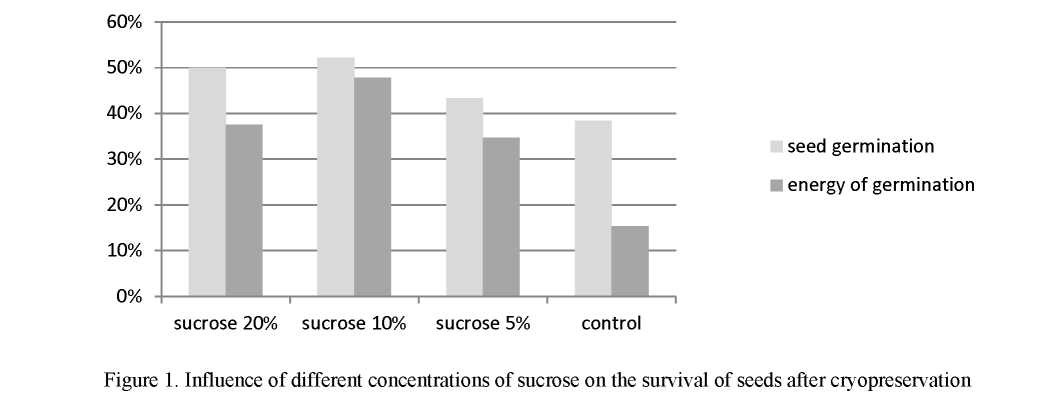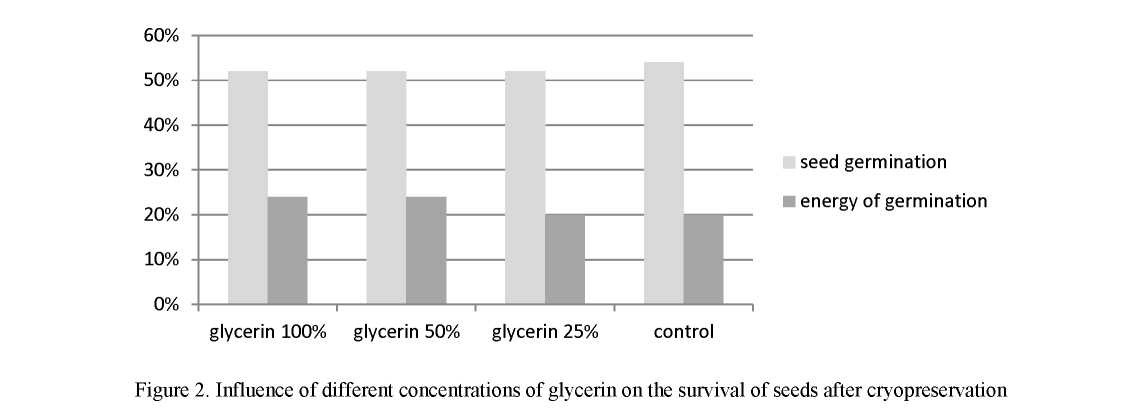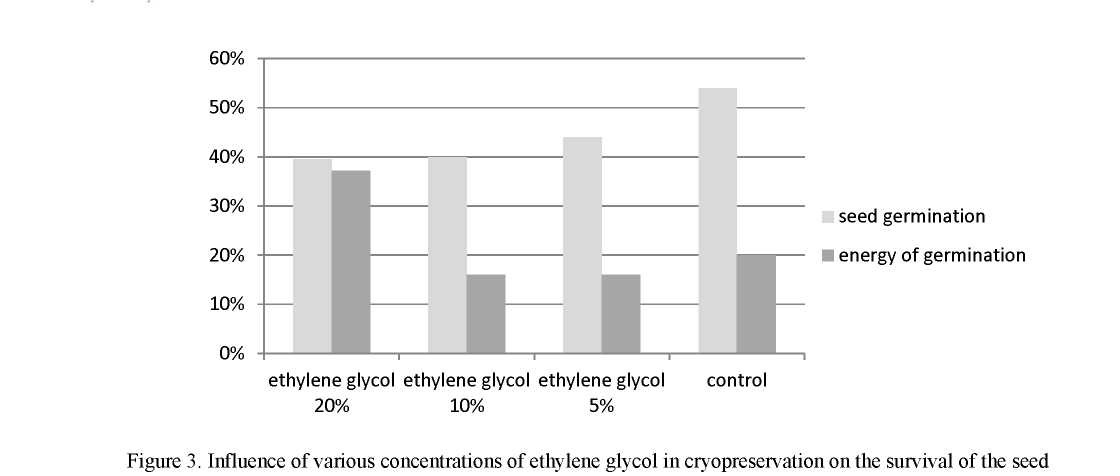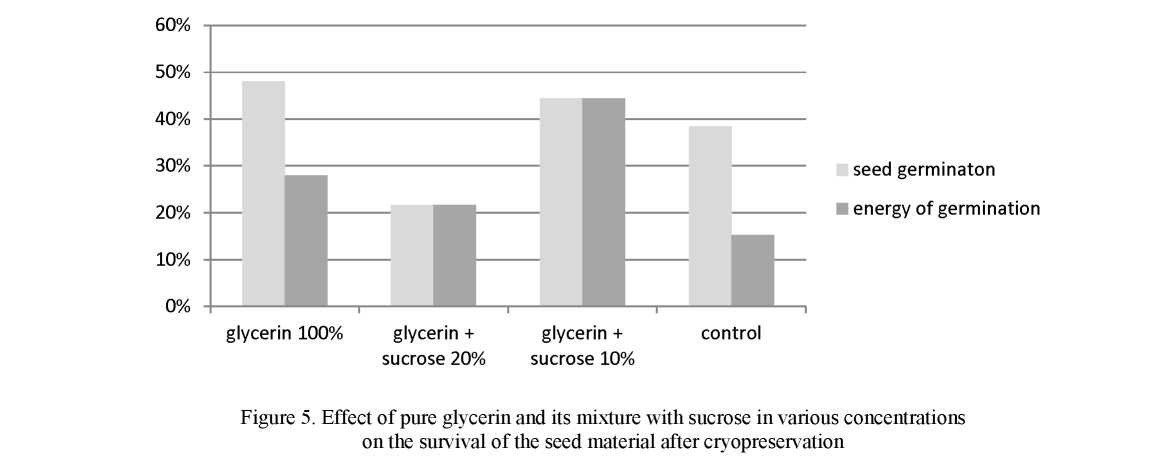In the article is described the method of cryopreservation of seed material of Achillea ledebourii. This endemic plant contains essential oils, alkaloids and glycosides. Conservation of species with limited distribution areas is a priority task. The most promising method for storing biological material is preservation in liquid nitrogen or in vapors. To maximizing viability of seeds various endocellular cryo protectants are used: glycerol, sucrose, ethylene glycol, dimethyl sulfoxide, and preservative mixtures. Seeds are frozen by simple immersion in liquid nitrogen. As a result of the experiments, it was determined that sucrose at a concentration 5 % and dimethyl sulfoxide — 10 % shew the best cryo protective properties. In the first case, seed germination after cryo freezing was 113 % concerning control data, which could be explained by the affection of the stratification effect; in the second case — 92 % from control data. The use of mixtures of cryoprotectants showed no synergistic effect, and, in comparison with pure substances, the degree of preservation of seed viability was less. The obtained data can be used for introducing this species into the cryo collection of seed material of endemic plants of Kazakhstan.
The main causes of the disappearance of plants are known for a long time, they are grazing cattle, deforestation in the tropics, the use of chemicals that affected on the ecosystems, the excessive harvesting of herbs for an industrial scale, the destruction of natural pollinators-insects. If we summarize all of the above, then we can see the destructive and thoughtless activity of a human being as a species living on the planet [1].
The traditional way of conservation was previously the way of creating collections of living plants, as well as seed material. However, living collections are an expensive method, which need in require constant care, protection from pathogens and insect pests. Seed banks cannot always fully ensure the identity of varietal qualities, since there is no way to track the direction of pollination of plants. Often, the obtained seed material gives a great diversity and splitting of the genes [2].
At present, an interesting method of preserving of plant material is cryopreservation with using extremely low negative temperatures. The most inexpensive and effective method is the storage in liquid nitrogen vapor.
Achillea ledebourii Heimerl (Asteraceae family) is a perennial plant until 70 cm tall. It grows predominantly on forest edges, meadows, grows well in steppes, along roads and along margins of fields, on the banks of reservoirs, among bushes, on fallow lands and wastelands, in villages [3].
Chemical composition. Yarrow is rich in phytoncides, alkaloids, saponins, polysaccharides, essential oils, tannins, resins and organic acids [3].
In the leaves of yarrow there is an essential oil rich in chamasulene, alkaloid achillein, esters, camphor, borneol, thujone, glycosides (luteolin and apigenin), cineoleum, tannins, resins, carotene, organic acids, amino acids, vitamins K, C, bitter. Minerals such as magnesium, potassium, boron, zinc, calcium, selenium, copper, and molybdenum have also been discovered [3]. It is an endemic plant of Altay and Kuznezkiy Alatau.
Methodology
Seed freezing was carried out in plastic tubes by direct immersion in liquid nitrogen. Thawing was carried out in two ways: slow, at room temperature; and fast — in a water bath with a temperature 80 °C.
When using the cryoprotectants the seeds were immersed in a protective substance or mixture for 10 minutes before deep freezing. After thawing, the cryoprotectants were washed three times with distillated water. After thawing the seeds were planted in Petri dishes on two layers of filter paper for determining their viability. The viability of the seeds was determined by two indicators: seed germination and germination energy [4].
Germination was determined as the percentage of sprouted seeds to the total number of seeds sown. Counting was carried out for 14 days. The energy of germination was defined as the germination on the 7th day. This parameter characterized the unity of germination and was one of the indicators of the preservation of the viability of the seed material.
One of the most important conditions for the preservation of biological material is viable; preventing cell cryo damage is the use of cryoprotectants. Endocellular cryoprotectants penetrate the cells and prevent the formation of intracellular ice, which destroys the cell mechanically [5, 6]. In our experiments, we used penetrating cryoprotectants, such as sucrose, glycerin, ethylene glycol and dimethyl sulfoxide. Seeds without freezing used as a control.
Results and discussion
After carrying out the experiment with sucrose solutions in various concentrations as a cryoprotector, it was determined that the best result of Achillea ledebourii's seed viability was maintained by a 10 % sucrose solution. The seed germination's rate in this case was 52.1±0.3 %, which was in 1.35 times greater than in the control variant, the germination energy was 47.8±0.2 %, which was in 3.12 times greater than in the control (Fig. 1). The lowest germination and germination energy values were obtained after using a sucrose solution 5 % — 43.4±0.2 % and 34.7±0.1 %, but the indices were higher than in the control variant in 1.13 and 2.26 times, respectively. Thus, the best option is a 10 % sucrose solution, while an increase in seed germination energy is almost 3 times, which is explained by the stratification effect.
In an experiment with glycerin as a cryoprotectant in various concentrations, it was determined that the results of the viability of the seeds were practically identical. With increasing concentrations of glycerin, the energy of germination increased on 4 %. When using a solution of glycerin in concentrations 100 %, 50 % and 25 %, the germination rate was 52±0.7 %, the germination energy was 24±0.3 %, and 24±0.2 % and 20±0.1 %, respectively. In control, the germination rate was 54±0.4 %, the germination energy was 20±0.2 % (Fig. 2).

Thus, we determined that the concentration of glycerin does not have a significant effect on the preservation of Achillea ledebourii's seed material. However, if one takes into account the germination energy, the best option is a pure polyhydric alcohol, as well as its 50 % solution.
In an experiment after using different concentrations of ethylene glycol as a cryoprotectant, we determined that the best percentage of germination is promoted by a solution of ethylene glycol 5 % — 44±0.4 %, the germination energy in this case was 16±0.3 %, similar as use of the ethylene glycol 10 % solution (Fig. 3).
The best indicator of conservation of germination energy belonged to a solution of ethylene glycol 20 % — 37.2±0.5 %. The germination rate after using an ethylene glycol solution 10 % was — 40±0.6 %, and after using a solution of ethylene glycol, 20 % was 39.5±0.5 %. As a result, it can be concluded that ethylene glycol as a cryoprotector didn't have a significant ability to preserve the viability of Achillea ledebourii's seed material, which was probably due to its toxicity. This was also evidenced by the fact that as the concentration of the ethylene glycol solution increased, the number of surviving seeds decreased. Thus, it is determined that ethylene glycol is not recommended to be used as a cryoprotectant for preserving Achillea ledebourii seeds in liquid nitrogen.
When we used dimethyl sulfoxide as a cryoprotectant in various concentrations, it was determined that the best results for maintaining the viability of the seeds was DMSO 10 % (Fig. 4). The germination rate was 50 %, the germination energy was 45.7±0.4 %, which was in 2.3 times higher than in the control data. The second place belonged to a solution of DMSO 20 %, germination was 48±0.6 %, and germination energy was 44±0.3 %.


The germs of DMSO solutions 50 % and DMSO 5 % were 22±0.4 % and 20±0.2 %, the germination energy was 4±0.1 % and 6±0.1 %, respectively. It can be assumed that 5 % solution of DMSO was not sufficient to maintain the viability of the seed embryo, while a concentration of 50 % led to the death of some seeds due to the toxicity of the cryoprotectant.
From the above data, it could be concluded that a solution of dimethyl sulfoxide 10 % had the best results of maintaining the viability of the seeds in comparison with other variants of dimethyl sulfoxide.
In the literature it is described that the use of mixtures of cryoprotectants contributed to better preservation of vital signs of biological objects during freezing in liquid nitrogen. This is due to the synergistic interaction of substances or their complementary action, in addition, in mixtures, lower concentrations of toxic compounds can be used, which increases the survival of cells. In our experiment, we applied freezing with glycerol and sucrose at various concentrations.
In an experiment we used a polyhydric alcohol-glycerin as a cryoprotector and its mixture with sucrose in various concentrations (Fig. 5). It was determined that the best protective ability belonged to a mixture of glycerol and sucrose 10 %, the germination rate was 44.4±0.6 %. Increasing the concentration of sucrose reduced the number of survivors seed after cryopreservation, the germination rate was 21.7±0.4 %.
In general, it should be noted that the use of this mixture of cryoprotectants did not show a synergistic effect, the number of surviving seeds was comparable in comparison with freezing in mono substance.
Серия «Биология. Медицина. География». № 1(93)/2019
11


Conclusion
Studying the effect of sucrose on the survival of seeds during cryopreservation, it turned out that sucrose solution 10 % contributed to the best result of viability preservation. The seed germination rate in this case was 52.1±0.3 %, which was in 1.35 times greater than in the control, the germination energy was 47.8±0.2 %, which was in 3.12 times greater than in the control. The lowest germination and germination rates were obtained after using a sucrose solution of 5 % — 43.4±0.2 % and 34.7±0.1 %.
It is found that ethylene glycol was not recommended as a cryoprotectant for the conservation of Achillea ledebourii's seeds in liquid nitrogen, since the growth indices in this variant of the experiment were lower than with other cryoprotectants.
When we used dimethyl sulfoxide as a cryoprotectant in various concentrations, it was determined that the best results for maintaining the viability of the seeds were DMSO 10 %. The germination rate was 50 %, the germination energy was 45.7±0.4 %, which was in 2.3 times higher than in the control. Both a decrease and an increase in the concentration of dimethyl sulfoxide led to a less secure seed material.
After using a mixture of glycerin and sucrose in various concentrations as a cryoprotector, it was found that the joint use of these protective substances did not lead to a greater preservation of the viability of the seeds, so their use was considered not rational.
The obtained results can be used for introducing this endemic plant species into the cryogenic collection of Kazakhstan plants.
References
- Kaviani, B. (2011). Conservation of plant genetic resources by cryopreservation. Australian Journal of Crop Science, 5, 6, 778–800.
- Belous, A.M., & Grishchenko, V.I. (1994). Kriobiolohiia [Cryobiology]. Kiev: Naukova dumka [in Russian].
- Tysiachelistnik: poleznye svoistva i protivopokazaniia [Yarrow: useful properties and contraindications]. zdravotvet.ru Retrieved from: http://zdravotvet.ru/lechebnye-svojstva-i-protivopokazaniya-tysyachelistnika-obyknovennogo
- Zorina, M.S., & Kabanov, S.P. (1987). Opredelenie semennoi produktivnosti i kachestva semian introdutsentov [Determination of seed productivity and quality of introduced seeds]. Metodiki introduktsionnykh issledovanii v Kazakhstane — Methods of introduction studies in Kazakhstan, 75–78. Alma-Ata: Nauka [in Russian].
- Rail, W.F., & Fahy, G.M. (1985). Ice-free cryopreservation of mouse embryos at -196 °C by vitrification. Nature, 313, 573575.
- Whittingham, D. G., Leibo, S. P., & Mazur, P. (1972). Survival of mouse embryos frozen to -196 and –269 oC. Science, 178, 4059, 411–414.